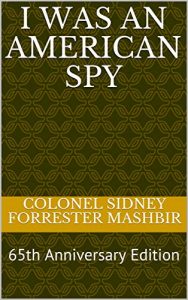
It is an honor to announce the publication of:
The 65th Anniversary Edition of Colonel Sidney Forrester Mashbir’s exciting 1953 autobiography:
I WAS AN AMERICAN SPY
Besides being a fascinating story, Colonel Mashbir’s autobiography is a textbook in the art of espionage and counter-espionage.
Colonel Mashbir (1891-1973) led an adventurous life – At the age of thirteen, he began his military career as a bugle boy in the Arizona Guard, in the still untamed Arizona Territory. During 1914-1916, he served under General Funston and General Pershing, and went on daring missions across the U.S./Mexican border during the Mexican Revolution, attempting to maintain stability between those nations. He personally escorted the Mexican revolutionary Pancho Villa to a peace parley with General Pershing in 1914.
During World War One, Mashbir protected U.S homeland security. He headed the U.S. Army’s Eastern Division of counter-espionage where he eliminated an extensive domestic spy network.
After WWI, Mashbir was attached to the U.S. Embassy in Japan in the early 1920s. Mashbir became fluent in the Japanese language and intimately familiar with the Japanese culture. During the early 1920s, Mashbir was sent on a perilous top secret mission into Russia and China, where he used his clever bluffing abilities to prevent a regional war.
During the two decades prior to WWII, Mashbir allied and befriended many leaders of Japan, including members of the Japanese Royal Family. Together, they strove to preserve peace between their nations. But the winds of war could not be stopped – When WWII erupted, Colonel Mashbir became General MacArthur’s top intelligence advisor – He commanded a top secret intelligence gathering organization called A.T.I.S. (Allied Translator and Interpreter Section) that dramatically shaped the successful strategy in the Pacific. In spite of it being many decades since the end of WWII, ATIS is still little known about. This organization was composed mainly of thousands of Japanese American Nisei (persons born in the United States whose parents were immigrants from Japan) who served as translators, interpreters, interrogators, and also went out into the battlefield. Their heroic contributions significantly shortened the war, saving countless lives.
Once WWII ended, Mashbir took a pivotal role in bringing Japan and the U.S. together again as allies. He served as translator and liaison between General MacArthur and Emperor Hirohito during eleven top secret meetings during the early reconstruction period of Japan.
As a pioneer of modern military intelligence, Mashbir was one of the two men who prepared the first draft implementing directives for the creation of the CIA (Central Intelligence Agency) at the request of the Joint Chiefs of Staff.
On a related note – The historical novel The Emperor and the Spy dramatically highlights the exciting life and accomplishments of Colonel Mashbir. The research required for writing this novel drew from Colonel Mashbir’s autobiography I Was an American Spy, combined with having access to Mashbir’s personal library of letters, official documents, and photos, along with many other historical resources discovered over two decades of research. TheEmperorAndTheSpy.com website presents this material thru blog posts.
Colonel Mashbir is an unsung American hero!
The 65th Anniversary Edition of his autobiography reveals the epic odyssey of this Master Spy who engaged in behind the scenes diplomacy and dangerous missions to shape world events.
The EBook is available on Amazon
Leave a Reply